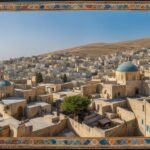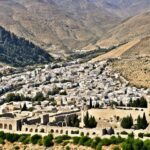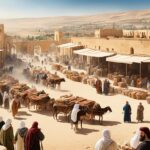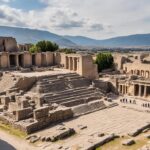Welcome to a fascinating journey into the historical and religious significance of Hebron in the Bible. Situated in the present-day West Bank, Hebron is an ancient city that holds a prominent place in biblical narratives, cultural practices, and theological themes. Join us as we dig deeper into the history, location, events, and significance of Hebron, exploring its connections to the Old Testament, the patriarchs, and the diverse communities that call this city their home.
Key Takeaways:
- Hebron is an ancient city with profound historical and religious significance in the Bible.
- It is mentioned in the Old Testament and associated with key biblical events and personalities.
- Located in the present-day West Bank, Hebron offers a wealth of archaeological discoveries.
- The city is revered by Jews, Christians, and Muslims for its religious and cultural heritage.
- Exploring Hebron allows us to delve into theological themes and gain insights into the foundations of faith.
Historical Significance of Hebron
Hebron is a city of immense historical significance, recognized as one of the oldest continuously inhabited cities in the world. Its roots trace back to biblical times, where it played a pivotal role in the lives of key figures and witnessed the rise and fall of empires.
“Hebron’s history intertwines with the narratives of the patriarchs and their journeys, making it an essential site for understanding the ancient world.”
In the Old Testament, Hebron is mentioned multiple times as the city where Abraham settled and King David was anointed. The significance of Hebron in the biblical narrative cannot be overstated, as it serves as a backdrop for profound events and stories that shaped religious and cultural traditions.
From the time of Abraham’s arrival in Hebron to the reign of King David, the city witnessed the unfolding of divine promises, the establishment of covenants, and the emergence of a nation destined for greatness. It is within the ancient walls of Hebron that the narrative of the Israelites took shape, paving the way for a rich tapestry of history and faith.
In exploring Hebron’s historical significance, one gains a deeper appreciation for the intricate connections between biblical narratives and the tangible remnants of the past. From the archaeological discoveries to the striking landscapes, Hebron encapsulates the spirit of an ancient city that has withstood the test of time.
To truly understand the Hebron of today, one must delve into its historical significance and immerse themselves in the stories of the past. By walking in the footsteps of the patriarchs, one can appreciate the enduring legacy that continues to shape Hebron’s identity and inspire generations to come.
Geographical Location of Hebron
Hebron is situated in the West Bank, a region in present-day Palestine. It is approximately 19 miles south of Jerusalem and rests among the hills of the Judean Mountains. The city’s strategic location allows for a commanding view of the surrounding landscapes, including the valleys and plains. Its proximity to major trade routes and fertile lands made it a vital center in the ancient world.
| Geographical Features | Details |
|---|---|
| Location | In the West Bank, approximately 19 miles south of Jerusalem |
| Topography | Rests among the hills of the Judean Mountains |
| View | Offers a commanding view of the surrounding landscapes, including valleys and plains |
| Trade Routes | Proximity to major trade routes |
| Fertility | Located in an area with fertile lands |
“Hebron’s geographical location, nestled among the hills of the Judean Mountains, provides breathtaking views of the valleys and plains. The city’s strategic position has played a significant role in its historical and cultural development. Its proximity to major trade routes and the fertile lands of the region have made Hebron a vital center throughout the ages.”
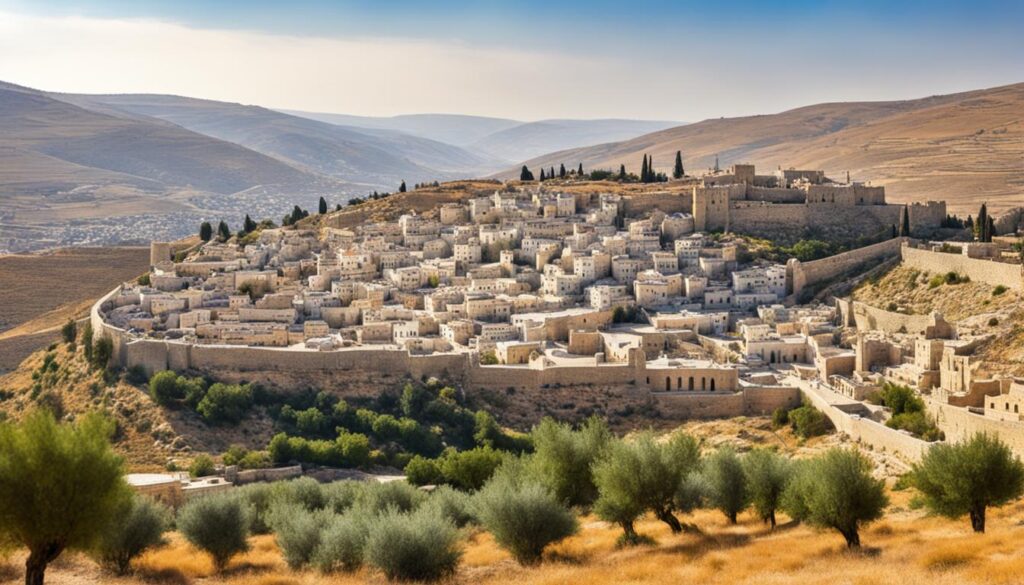
Archaeological Discoveries in Hebron
Hebron’s archaeological heritage is a treasure trove of rich and diverse discoveries. Through meticulous excavations, layers of human habitation dating back thousands of years have been uncovered, unraveling the secrets of the city’s ancient past.
These archaeological findings provide invaluable insights into different civilizations that once thrived in Hebron, shedding light on various aspects of daily life, culture, and societal structures during different historical periods.
One of the notable archaeological sites in Hebron is the ruins of Beit Romano, an Ottoman-era mansion. These ruins stand as a testament to the city’s evolving architectural styles and the historical influences that shaped its urban landscape.
Another significant site is Tel Rumeida, an ancient tell that serves as a focal point for understanding the city’s history. Excavations at Tel Rumeida have unearthed remnants of ancient structures, pottery, and artifacts, providing valuable clues about Hebron’s past civilizations.
The archaeological discoveries in Hebron not only offer a glimpse into the past but also contribute to our understanding of the region’s historical significance on a global scale. Through these ancient ruins, we can piece together the puzzle of Hebron’s vibrant and complex history, enriching our knowledge of the civilizations that once thrived in this ancient city.
Theological Themes in Hebron
Hebron is not only a city of historical and archaeological significance but also holds great theological importance in the Bible. Through its connection to the stories of Abraham, Sarah, Isaac, Rebecca, Jacob, and Leah, Hebron embodies various significant biblical themes.
Symbolic Representation of Faith, Covenant, and Divine Promises:
In the biblical narrative, Hebron is portrayed as a symbol of faith, covenant, and the fulfillment of divine promises. It was in Hebron that God made a covenant with Abraham, promising him numerous descendants and the land of Canaan as an inheritance. The city serves as a reminder of the faithfulness of God and the trust that Abraham had in His promises.
A Backdrop for Narratives of Faithfulness:
Throughout the Bible, Hebron is the setting for various narratives of faithfulness. The stories of Abraham, Sarah, Isaac, Rebecca, Jacob, and Leah unfold in the context of their journeys and experiences in Hebron. These narratives highlight the complex relationship between humanity and God, showcasing qualities such as trust, obedience, sacrifice, perseverance, and resilience.
In exploring Hebron, one can engage with these theological themes and delve deeper into the biblical narratives that have shaped the foundations of faith for generations.
Key Theological Themes in Hebron:
| Theological Theme | Description |
|---|---|
| Faith and Trust | Hebron symbolizes the importance of unwavering faith and trust in God’s promises. |
| Covenant | Hebron is the place where God initiated covenants with Abraham and his descendants. |
| Fulfillment of Divine Promises | The city represents the fulfillment of God’s promises, including the inheritance of the land of Canaan. |
| Complex Relationship between Humanity and God | Through the narratives in Hebron, the complex dynamics of faith, obedience, and divine intervention are explored. |
Key Biblical Events in Hebron
Hebron is a city that holds great significance in the Bible, being the setting for several key events that shaped biblical narratives and the history of the Israelites. From the purchase of the Cave of the Patriarchs to the reign of King David, Hebron played a crucial role in the lives of biblical figures and the establishment of their legacies.
Abraham’s Purchase of the Cave of the Patriarchs
In Hebron, Abraham purchased the Cave of the Patriarchs as a burial site for his family members, including Sarah, Isaac, and Jacob. This act emphasized his deep connection to the land and his belief in the promises of God. The Cave, also known as the Ibrahim Mosque, is a significant religious and historical site, revered by multiple faiths.

Abraham’s Angelic Visitors
It was in Hebron that Abraham received three angelic visitors who announced the birth of his son, Isaac. This event revealed the divine intervention in Abraham’s life and served as a confirmation of the fulfillment of God’s promises. The visitation of the angels marked a crucial turning point in the patriarch’s journey of faith.
King David’s Rule in Hebron
Prior to establishing his capital in Jerusalem, King David ruled over Judah from Hebron for seven years. This period marked the beginning of his reign as the king of Israel and the expansion of his influence. Hebron was a strategic city in David’s quest for establishing a united kingdom and solidifying his authority.
These key biblical events in Hebron reflect the intertwining of faith, destiny, and historical significance. They offer a glimpse into the lives of the patriarchs and the origins of the Israelite nation. Hebron’s role in these narratives showcases its enduring importance as a place of divine encounters and foundational moments in biblical history.
Cultural and Religious Practices in Hebron
Hebron is a city that has preserved its cultural and religious practices over centuries. It serves as a melting pot of diverse communities, including Palestinian Muslims and Christians, as well as Jewish settlers. Each community brings its unique traditions, rituals, and religious observances, contributing to the vibrant tapestry of Hebron’s cultural identity.
“Hebron’s dynamic cultural landscape is a testament to the coexistence of different religious and ethnic groups, each enriching the city with their customs and practices.”
The cultural heritage of Hebron is reflected in its bustling markets, colorful festivals, and architectural landmarks. The city’s markets offer a sensory experience, where locals and visitors alike can immerse themselves in the vibrant atmosphere, taste traditional cuisine, and discover handicrafts. During festive occasions, Hebron comes alive with musical performances, traditional dances, and religious processions, showcasing the deep-rooted cultural practices of its inhabitants.
Architectural landmarks in Hebron bear witness to the city’s storied past and religious significance. The Cave of the Patriarchs, also known as the Ibrahim Mosque, stands as a symbol of religious tolerance and devotion, attracting pilgrims from different faiths. Its grandeur and historical significance make it a focal point for prayer and reflection.
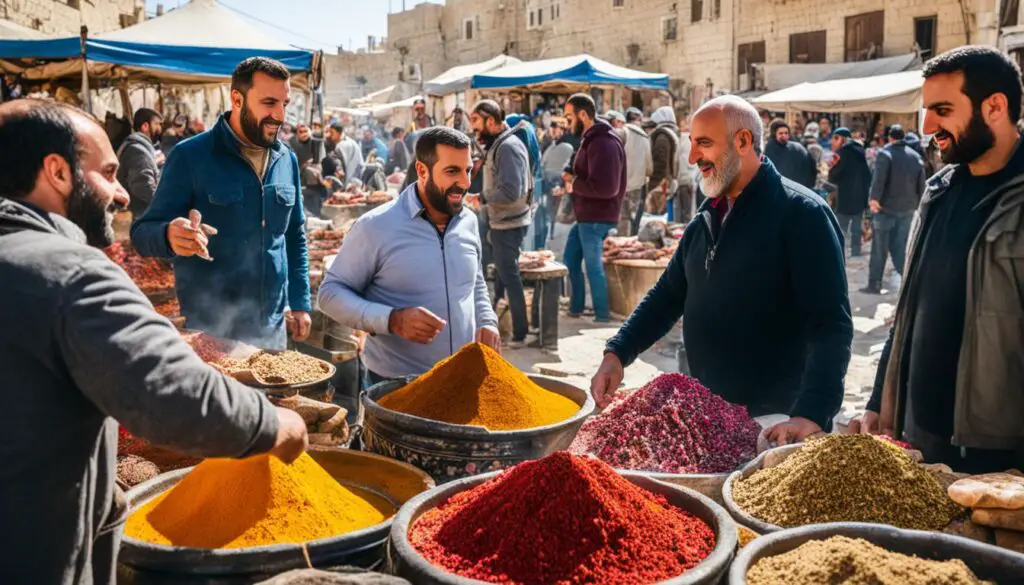
Annual Festivals in Hebron
Hebron hosts a variety of annual festivals that celebrate its cultural diversity and religious customs. These festivals provide a platform for communities to come together, share their traditions, and promote mutual understanding:
- Hebron International Women’s Festival: A celebration of women’s achievements in various fields, including art, literature, and entrepreneurship.
- Hebron Summer Festival: A joyful event featuring music performances, dance shows, and cultural exhibitions.
- Palestinian Olive Harvest Festival: Honoring the importance of olive cultivation in Palestinian culture, this festival celebrates the harvest season with traditional music, food, and activities.
- Christmas Celebrations: Hebron’s Christian community commemorates Christmas with religious services, processions, and the lighting of the Christmas tree in Manger Square.
These festivals provide an opportunity to experience the vibrant traditions and customs that contribute to the cultural fabric of Hebron.
| Religious Community | Key Customs and Practices |
|---|---|
| Palestinian Muslims |
|
| Palestinian Christians |
|
| Jewish Settlers |
|
These diverse cultural and religious practices in Hebron create an atmosphere of coexistence, mutual respect, and appreciation for the city’s rich heritage.
Prophetic and Eschatological Significance of Hebron
Hebron holds prophetic and eschatological significance in various religious traditions. It is deeply intertwined with the belief in the future redemption and restoration of the land and people of Israel. For believers, Hebron represents a symbolic link to the Messianic era and the ultimate fulfillment of God’s promises. The city’s religious and historical importance serves as a focal point for eschatological interpretations and hopes.
“And behold, I am with you and will keep you wherever you go, and will bring you back to this land. For I will not leave you until I have done what I have promised you.” – Genesis 28:15
Prophetic Promise and Restoration
Throughout the Bible, Hebron is associated with significant prophetic promises and the restoration of God’s chosen people. The city holds a special place in the hearts of believers who see its future as intricately connected to the fulfillment of divine plans.
- The Covenant with Abraham: Hebron is the city where Abraham received the promise of descendants as numerous as the stars and the land as an everlasting possession (Genesis 15:18-21).
- The Land of Promised Inheritance: Hebron is part of the land promised to the Israelites, and its prophetic significance extends to the healing and restoration of the nation (Ezekiel 36:1-12).
- The Messianic Hope: Many believe that Hebron is linked to the coming of the Messiah, who will usher in a time of peace, justice, and the complete renewal of the land and its people.
Eschatological Interpretations
Eschatology, the study of end times, finds resonance in Hebron’s historical and religious context. It has become a site of eschatological interpretations among believers, who anticipate the future fulfillment of God’s plans within the city and its surroundings.
- The Restoration of Israel: Hebron symbolizes the eventual restoration of the nation of Israel and the unification of all twelve tribes in the Messianic age.
- The Kingdom of God: Believers see Hebron as a foretaste of God’s kingdom, representing the unity, peace, and divine presence that will reign in the new Jerusalem.
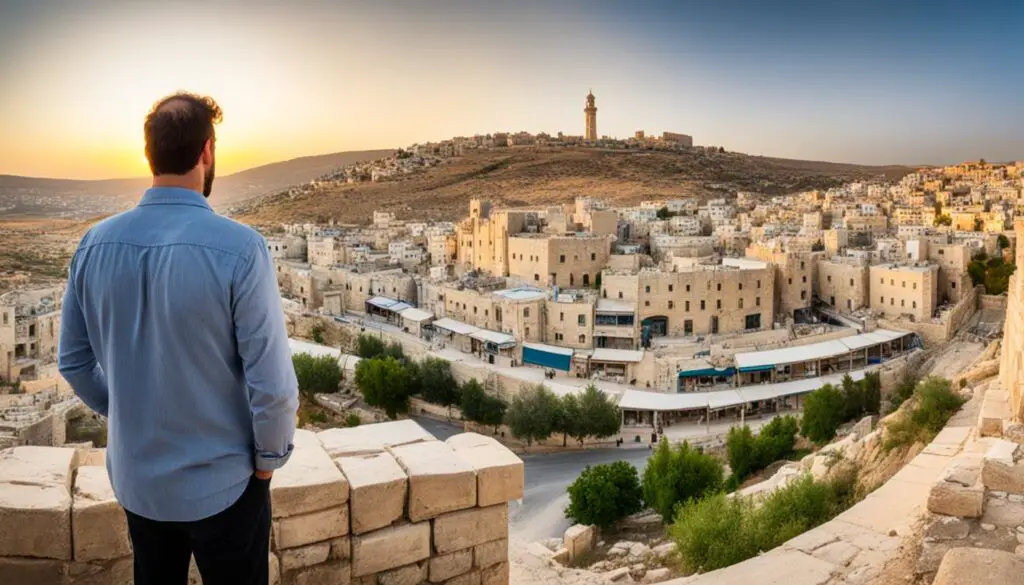
Hebron’s prophetic and eschatological significance continues to inspire faith and hope in the hearts of believers around the world. Its historical and religious importance connects present-day believers to ancient promises while looking forward to the ultimate fulfillment in the future.
Explore Hebron Today
Hebron offers visitors a chance to explore its rich history and experience its religious sites. There are several attractions that are a must-visit for anyone interested in the city’s heritage.
- The Cave of the Patriarchs (Ibrahim Mosque): This sacred site is of immense religious significance and holds the tombs of Abraham, Sarah, Isaac, Rebecca, Jacob, and Leah. It is a place of prayer and pilgrimage for people of different faiths.
- The Oak of Abraham: A majestic tree believed to have been planted by Abraham himself. It is a symbol of ancient traditions and serves as a reminder of the city’s ancient roots.
- Beit Romano: Explore the ruins of an Ottoman-era mansion that provides insights into the city’s history and architecture. It offers a glimpse into the grandeur of the past.
- Tel Rumeida: Visit this ancient tell to gain a deeper understanding of Hebron’s archaeological significance. It showcases layers of human habitation and reveals the city’s rich past.
- The Tomb of Yishai: Pay homage to the burial site of Jesse, the father of King David. It is a place of spiritual connection and reverence.
- Abraham’s Well: Discover the well that is traditionally associated with Abraham, one of the central figures in the Abrahamic faiths. It is a symbol of sustenance and life.
The Old City of Hebron is a vibrant and bustling hub that transports visitors back in time. Its narrow streets, bustling markets, and ancient buildings create a captivating atmosphere. As you wander through the city, you’ll witness the everyday lives of the people who call Hebron home.
If you’re interested in delving deeper into Hebron’s heritage, the city is also home to cultural centers, museums, and Hebron University. These institutions offer valuable insights into the city’s history, art, and contemporary life.
Exploring Hebron is an opportunity to immerse yourself in the ancient traditions, religious practices, and architectural wonders that make this city a truly remarkable destination.

Conclusion
Hebron in the Bible offers a captivating journey into an ancient city steeped in historical and religious significance. From its geographical location in the West Bank to its remarkable archaeological discoveries, Hebron leaves an indelible mark on those who explore its depths. The city’s theological themes, key biblical events, cultural practices, and prophetic implications contribute to its status as an essential destination for those seeking a deeper understanding of faith and heritage.
By visiting Hebron, one can immerse themselves in the narratives of the patriarchs and witness the tangible remnants of their lives. The rich tapestry of cultural practices and religious observances provides a glimpse into the city’s vibrant identity and the diverse communities that call it home. Hebron’s prophetic significance adds a layer of hope and anticipation, resonating with believers from different religious traditions.
In Hebron, the past and present intertwine, creating a unique experience that connects visitors with the foundations of faith. It is an opportunity to delve into the rich history and appreciate the enduring legacy of an ancient city that continues to shape our understanding of the world. Whether for the devout or the curious, Hebron offers a window into a bygone era and a chance to reflect on the timeless truths found within its boundaries.


